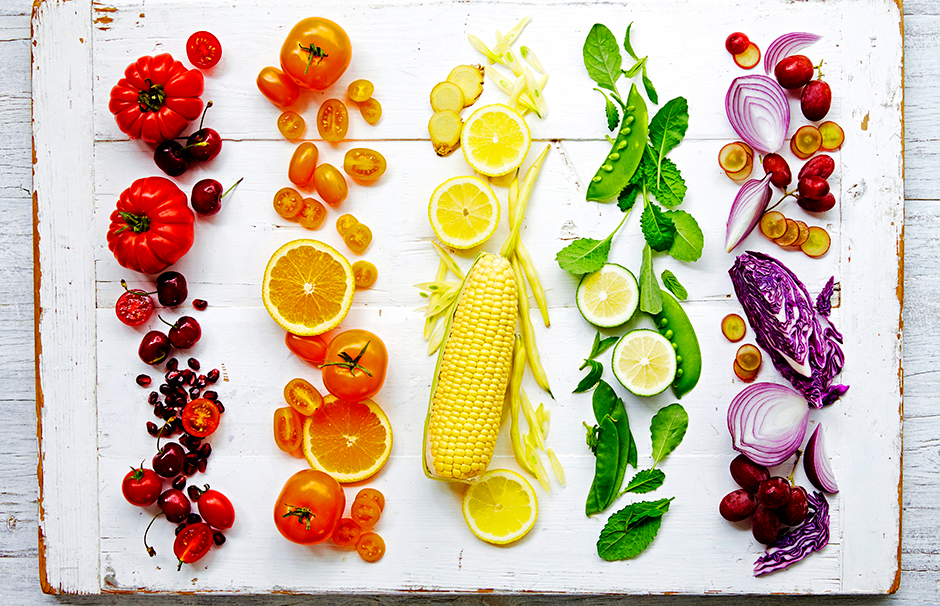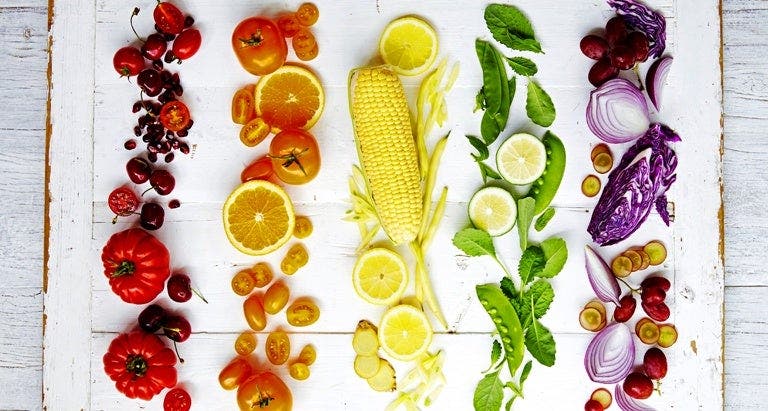Eat the rainbow: why you should load your plate with colourful foods


The key to a healthy diet is variety, particularly when it comes to fruit and vegetables. Both are important for good health; NHS guidelines recommend eating at least five portions of fruit and veg a day.
Different fruits and vegetables contain different combinations of fibre, vitamins, minerals and other nutrients, so you should try to eat a variety. Choosing different coloured fruit and veg is a good way to make sure you do this - so mix things up by eating the rainbow throughout the week.
The majority of fruit and vegetables, fresh, tinned or frozen, are also Point™ foods, so you can enjoy them freely with WW.
Here are some of the health benefits of eating different coloured fruit and veg.
White food health benefits
Mushrooms
Cauliflower
Onion
Garlic
White vegetables contain selenium, B vitamins and vitamin C. Garlic and onion contain sulphur compounds that can have anti-cancer and heart-health effects, while mushrooms provide more vitamin B12 and D than many other plant foods.
TIP: Try adding cauliflower, mushrooms and garlic to stir-fries, and potatoes, swedes and turnips to tasty and satisfying winter casseroles.
RECIPE: Quorn, cauliflower and spinach curry
Orange/yellow food health benefits
Carrot
Sweet potato
Pumpkin
Apricots
These sunny veggies and fruit boast nutrients like beta-carotene, vitamin C and A, potassium and carotenoids, which are antioxidants that have been linked to the prevention of certain cancers and heart disease. Carrots are the richest source of beta-carotene, a potent antioxidant that’s converted to vitamin A by the body and is also involved in boosting immune function.
TIP: Orange/yellow veggies such as carrot, sweet potato and pumpkin are delicious roasted and added to salads. Fruits of the same colour spectrum, like apricots or mangoes, are great for snacks and for making healthy desserts.
RECIPE: 6 savoury, sweet and tasty carrot recipes
Red food health benefits
Strawberries
Raspberries
Chilli
Peppers
Tomatoes
Red produce contains vitamin C and folate, as well as the powerful antioxidant, lycopene. Hailed for its ability to protect the prostate gland, the lycopene present in cooked tomatoes may also protect the skin from sunburn by helping it guard against harmful UV rays. Plus, Harvard researchers found women who ate two or more servings of strawberries a week were less likely to have elevated C-reactive protein levels, a blood biomarker that signals the presence of inflammation in the body.
TIP: Use red chilli, peppers and tomatoes to make a hearty pasta sauce. Red fruits such as strawberries and raspberries are good cereal toppings.
RECIPE: Try this tomato olive tart
Green food health benefits
Broccoli
Spinach
Avocado
Kiwi fruit
Finish all your greens and you’ll get a dose of nutrients including vitamin A, iron, calcium and the antioxidants, lutein and zeaxanthin, which help to protect your eyes. In addition, they also provide sulforaphane, which has been shown to have significant anti-cancer effects.
TIP: Try sautéing spinach with garlic, adding lightly steamed broccoli to salads, and spreading avocado in a sandwich instead of butter. Include green fruits such as kiwi fruit and honeydew melon in fruit salads.
RECIPE: Mango, avocado and chickpea rice salad
Purple/blue food health benefits
Red cabbage
Blueberries
Aubergine
Beetroot
Red onions
These veggies contain vitamin C, manganese and fibre, as well as anthocyanins, potent antioxidants that may enhance brain function, slow the mental decline associated with aging and promote heart health.
TIP: Include red cabbage and red onions in a bright coleslaw, and chargrill aubergine or roast beetroot to make nutritious side dishes. In summer, snack on fresh blueberries, and add the frozen variety to porridge during autumn and winter.
